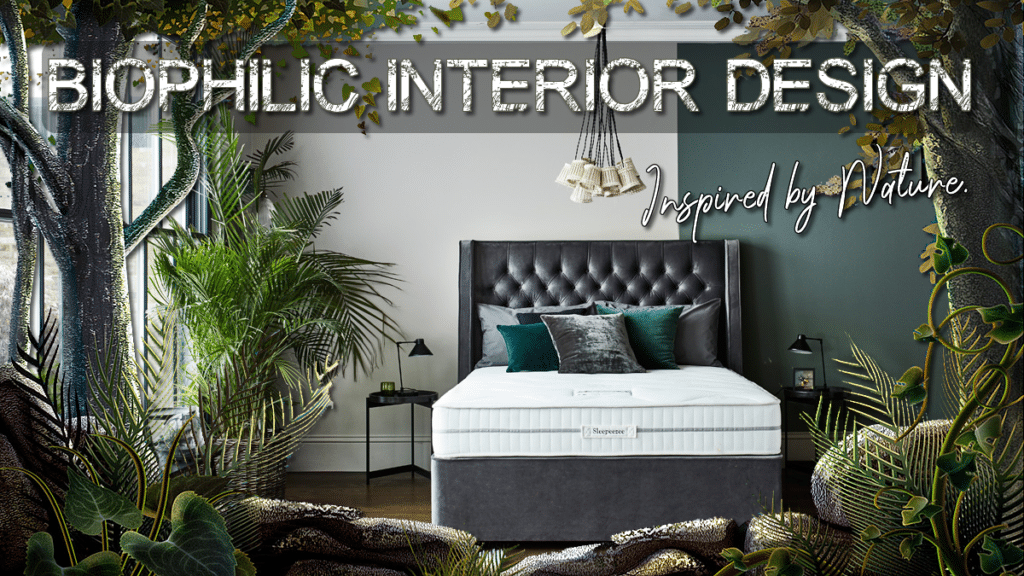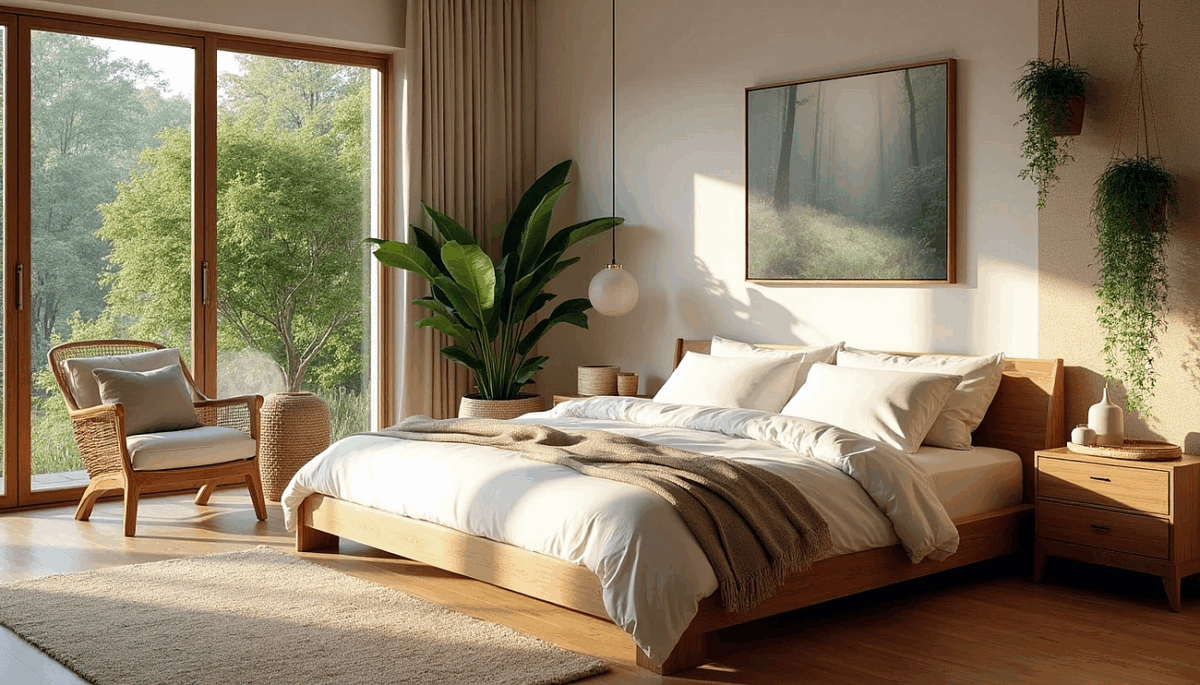Free UK Delivery*
0% Finance Available
Old Bed & Mattress
Sleep Talk Blog, Health & Wellbeing
How to Create a Biophilic Bedroom Design: A Sleep Expert's Guide
Table of Contents
Did you know that spending time around nature can slash your stress levels, give your immune system a proper boost, and even help lower your blood pressure?
Scientists have discovered that getting outdoors regularly sharpens your memory, helps you think more clearly, lifts your mood, and gives you a real sense of direction in life. Yet here's the thing – most of us spend over 90% of our time trapped indoors, cut off from the natural world our bodies actually crave.
Your bedroom should be your own personal sanctuary. A space where you can truly unwind and let your body do what it does best – restore itself through quality sleep. This is exactly where biophilic bedroom design works its magic.
What if you could bring those incredible benefits of nature right into your sleep space? When people spend time in rooms designed with natural elements, they feel calmer, think more clearly, and sleep so much better. Pretty amazing, right?
Sleep quality should be your number one priority when thinking about your bedroom. Poor sleep doesn't just leave you feeling groggy – it actually increases your risk of serious health problems like high blood pressure, heart disease, diabetes, and depression.
The brilliant news? Even small changes that connect you with nature can make a massive difference to how well you sleep. Your body is naturally wired to respond to the outdoors, so working with this instinct rather than against it makes perfect sense.
From sunlight that keeps your body clock ticking smoothly to natural materials that feel wonderful against your skin, biophilic design principles can completely change how you experience sleep. Ready to discover how to bring the outside world into your bedroom? We'll show you exactly how to create a space that's not just beautiful to look at, but actually helps you drift off into the best sleep of your life.

Understanding Biophilic Design and Its Sleep Benefits
Biophilic design is all about creating spaces that tap into your natural connection with the living world. This isn't just about making rooms look pretty – it's about working with your biological wiring to create environments that genuinely improve how you sleep and feel.
What is biophilic interior design?
The word "biophilia" comes from ancient Greek, meaning "the love of living things". Psychoanalyst Erich Fromm first coined the term in 1973, and biologist Edward O. Wilson developed it further in 1984. Biophilia describes our built-in tendency to seek connections with nature and other living systems. Wilson suggested this connection runs deeper than we might think – we're actually genetically programmed to connect with nature because we evolved in natural environments for most of human history.
Biophilic interior design takes this concept and applies it to the spaces where we live and sleep. The idea is beautifully simple: connect people with nature to boost wellbeing. You'll find this design approach works in three main ways:
- Nature in the space - Bringing actual nature indoors through plants, water, light, and fresh air
- Nature of the space - Designing room layouts that feel like natural environments (think cosy reading nooks that give you that sense of shelter)
- Natural analogues - Using materials, colours, patterns, and shapes that remind us of the outdoors
When you put biophilic design into practice, you're looking at elements like natural lighting, indoor plants, water features, natural materials such as wood and stone, earthy colour palettes, organic shapes, and patterns inspired by nature. Plants might be the most obvious element, but biophilic design goes much further – it includes fractal patterns that mirror nature's organised complexity and natural light that keeps your body clock running smoothly.
How nature impacts sleep and mental health
Your connection to nature plays a huge role in how well you sleep and how you feel mentally. Research shows that green space exposure is absolutely crucial for both sleep quality and quantity. Some fascinating studies on forest bathing have found that people can gain up to an extra hour of sleep after spending mindful time outdoors.
The sleep benefits work through several pathways. Natural light exposure is key for regulating your circadian rhythms – those internal 24-hour clocks that respond mainly to light and darkness. Getting morning sunlight helps reset these rhythms, leading to better sleep patterns overall. Plus, spending time around green landscapes tends to make you more physically active, which naturally supports better sleep.
Natural environments also give your mind a break. They don't demand much mental energy or attention, making them perfect for stress reduction. This explains why people who live near greenery – including gardens and tree-lined streets – are 92% more likely to sleep well. Nature exposure also lowers stress levels, reduces blood pressure and heart rate, eases chronic pain, and sharpens cognitive function.
The mental health benefits stretch well beyond sleep. Biophilic design has been proven to reduce stress, encourage relaxation, and improve psychological wellbeing. This makes incorporating biophilic principles into your bedroom particularly important, since quality sleep affects your mental, heart, brain, and immune health.
Here's something encouraging for your bedroom design: even small natural touches can trigger positive responses in your body. Research shows that simply looking at pictures of nature, plants, and outdoor scenes can have similar mental effects to actually being outdoors in real natural environments. This means biophilic bedroom design works for everyone, no matter how much space or budget you're working with.
Letting Nature In: Light, Air, and Views
Sunlight, fresh air, and a proper view of the outdoors – these are the building blocks that'll turn your bedroom into a genuine sleep sanctuary. Think of them as the foundation for everything else you'll add to create your biophilic bedroom design.

Why should you focus on natural light first?
Natural light does so much more than just brighten your room. Sunlight boosts serotonin levels in your brain, which naturally lifts your mood and calms anxiety. Plus, getting your daylight strategy right can slash your energy bills by up to a third.
Here's how to make the most of every ray:
- Sort your window treatments - Sheer curtains or light-filtering blinds give you privacy whilst letting precious daylight stream through. Solar shades with 1-10% filtering work brilliantly for this balance.
- Position mirrors cleverly - Pop a mirror opposite your window and watch it double the sunlight entering your space. Mirrored furniture or reflective accessories spread light beautifully around the room.
- Pick the right paint colours - Choose wall colours with a light reflectance value of 70 or higher. Whites, soft pastels, pale blues, creamy beiges, and gentle greens bounce back over 80% of the sunlight that hits them.
- Think about paint finishes - Matte finishes scatter light softly without harsh glare, whilst glossy finishes give you more intense light reflection.
Get your air flowing properly
Poor air quality can seriously mess with your sleep. Most of us shut our bedroom doors and windows at night, which just traps stale air and pollutants inside.
Start with these simple fixes:
- Open a window just a crack (even an inch or two helps) to let stale air escape – though skip this during high pollen days or when outdoor air quality's poor
- Set your heating system fan to 'on' instead of 'auto', especially at night
- Use ceiling fans or portable fans to keep air moving – during warmer months, set ceiling fans to spin anticlockwise for a cooling breeze
- Check your furniture isn't blocking air vents
- Consider a standalone air purifier with HEPA filters to tackle gases and odours
Position your bed for the perfect view
Where you place your bed makes a massive difference to your connection with nature. Having something green or natural to look at from your pillow creates that vital link to the outdoors.
Try these positioning tricks:
- Face your windows - Arrange your bed to look towards windows with outdoor views. No decent view? Nature photography or artwork can work similarly well.
- Frame what you've got - Choose window treatments you can open completely when you want the full view. Light, flowing curtains that frame rather than block create a lovely window to the outside world.
- Create your own view - Got an uninspiring outlook? Window boxes with plants or hanging gardens can transform what you see.
- Bring nature closer - Position plants where you can see them from bed. Even pictures of natural landscapes can trigger the same feel-good responses as being outdoors.
Takeaway Tip: these three elements – light, air, and views – work best when they're all considered together, creating the perfect foundation for your sleep sanctuary.
Don't forget, these natural elements form the backbone of everything else you'll add to your bedroom. Get these basics right, and you'll have created the perfect starting point for deeper, more restful sleep.
Choosing the Right Plants for Your Bedroom

Plants are absolute game-changers when it comes to creating your perfect biophilic bedroom. Beyond looking gorgeous, they actually work hard to support better sleep quality. The trick is picking plants that won't demand constant attention whilst delivering real benefits to your sleep space.
Low-maintenance plants that purify air
Some plants are natural superstars at cleaning your bedroom air without being high-maintenance. Snake plants are brilliant bedroom companions because they do something most plants can't – they convert carbon dioxide into oxygen at night rather than just during the day. This night-time oxygen boost makes them perfect for where you sleep.
Peace lilies earned their spot on NASA's top air-purifying list by tackling nasty toxins like formaldehyde, benzene, and ammonia. They're also happy in low-light conditions, so they'll thrive even in bedrooms that don't get masses of natural light.
Spider plants join the night-time oxygen club, helping you breathe easier whilst you sleep. They're also busy filtering out common household pollutants including benzene, formaldehyde, carbon monoxide, and xylene. Perfect if you're new to plant parenthood – they're incredibly forgiving.
Looking for other low-fuss options? Consider these reliable choices:
- ZZ plants practically thrive on neglect, needing minimal water and happy in dim corners
- Pothos tackle formaldehyde, carbon monoxide, and benzene whilst adapting to different light levels
- Aloe vera release oxygen at night and keep your air clean
Where to place plants for best effect
Plant placement makes all the difference to both their health and your sleep benefits. Position oxygen-producing plants like snake plants or aloe vera close to your bed to maximise those night-time benefits.
Windowsills work brilliantly for plants that love bright, indirect light, whilst shade-loving options like peace lilies prefer east or west-facing windows. Tight on floor space? Hanging plants or wall-mounted planters give you all the biophilic benefits without cluttering your bedroom.
Create a stunning focal point by placing taller plants like bamboo palm in room corners. Your nightstands and dressers also make perfect spots for smaller plants – just make sure you protect your furniture with proper drainage.
Alternatives to live plants
Live plants aren't for everyone, and that's perfectly fine. There are other ways to bring natural elements into your bedroom design.
Preserved plants offer the best of both worlds. These are real plants that have been specially treated to maintain their natural look and feel without needing water, sunlight, or any care. Your brain still recognises them as natural, giving you similar biophilic benefits to living plants.
Artificial plants work well in very dark spaces or if you travel frequently. They're also brilliant for allergy sufferers, giving you the visual benefits without pollen or sap. Just remember they won't clean your air like living plants do.
Why not mix both approaches? Place real plants in bright, easy-to-reach spots and artificial ones in trickier locations. This way you get the best of both worlds without the hassle.
Natural Materials and Textures That Support Sleep
The textures and materials around you as you sleep can make or break your night's rest. Think about it – you're spending a third of your life in direct contact with these surfaces, so shouldn't they work with your body rather than against it?
Why wood, stone, and clay make such brilliant bedroom choices
Wood brings something magical to your sleep space that plastic simply can't match. Solid wood furniture actually gets better with age, developing a rich patina that connects you to nature's own ageing process. Studies show that rooms with wooden elements help lower your heart rate and stress levels compared to spaces filled with synthetic materials. Even small touches like a wooden picture frame or bedside table can deliver these calming benefits.

Stone and clay elements ground your bedroom in a way that feels deeply satisfying. These natural materials work as temperature regulators, soaking up heat during the day and gently releasing it at night. Each piece tells its own story through unique patterns and textures – something you'll never get from mass-produced plastic alternatives. Clay plasters on walls offer an extra bonus by naturally balancing humidity levels, which is fantastic news if you suffer from breathing issues.
Choose bedding that breathes with you
What's touching your skin for eight hours every night? The fabric choices you make here directly affect how well you sleep.
Linen deserves special mention – this flax-derived fabric can absorb up to 20% of its weight in moisture without feeling damp against your skin. It's brilliant at keeping you cool in summer and cosy in winter, plus it gets softer and more comfortable with every wash.
Organic cotton offers natural breathability that synthetic alternatives simply can't match. It wicks moisture away from your body, preventing that sticky, uncomfortable feeling that can wake you up during the night.

The synthetic materials to avoid
Synthetic materials create barriers between you and the restorative sleep your body craves. Polyester sheets trap heat and sweat against your skin, causing those annoying temperature spikes that jolt you awake. Vinyl flooring and synthetic carpets can continue releasing chemicals into your bedroom air for years, compromising the quality of every breath you take.
The beauty of choosing natural materials? Each swap you make strengthens your connection to the outdoors – and your body responds to this instinctively with better, deeper sleep.
Colours, Sounds, and Scents That Mimic Nature
Plants and natural light are just the beginning of your biophilic bedroom journey. The colours you choose, the sounds that fill your space, and even the scents floating through the air all work together to create that perfect connection to nature your body craves.
Earth tones and nature-inspired palettes
The colours surrounding you each night have more power over your sleep than you might think. Nature-inspired shades like soft greens, calming blues, and warm browns don't just look beautiful – they actually help your mind settle into sleep mode.
Here are some gorgeous nature-inspired options for your bedroom:
- Sage and seafoam greens bring that fresh, balanced feeling you get when you're surrounded by lush foliage
- Warm neutrals such as taupe, khaki and pale terracotta create an instant sense of comfort and security
- Earthy browns from soft almond to rich chestnut build layers of cosiness, especially when you mix different brown tones together

Skip those stark, bright whites that can feel a bit clinical. Instead, embrace off-whites like cream and vanilla – they give you that clean, neutral base whilst adding just enough warmth to make your space feel naturally inviting.
Bring natural sounds into your sleep space
Have you ever noticed how the sound of gentle rain or ocean waves can make you feel instantly relaxed? Your bedroom can capture these same soothing effects, even if you're miles from the nearest beach or forest.
Small water features like tabletop fountains create the most beautiful natural soundtrack. That gentle trickling sound works wonders for masking any outside noise whilst giving your mind something peaceful to focus on as you drift off.
Don't have space for a water feature? Sound machines offering forest sounds, ocean waves, or soft rainfall can work just as well. These natural soundscapes help your brain switch off from the day's stress and settle into that perfect sleep state.
Using essential oils and natural scents

Scent might be the most overlooked element in bedroom design, but it's absolutely worth getting right. Natural fragrances can signal to your body that it's time to wind down and prepare for rest.
Some of the best sleep-supporting scents include:
- Lavender – the ultimate bedtime scent that actually helps slow your heart rate and lower blood pressure
- Frankincense with its warm, earthy aroma that helps deepen your breathing and quiet busy thoughts
- Vetiver offering deep, grounding notes that create an instant sense of calm
You can enjoy these scents through diffusers, pillow sprays, or even small bundles of dried herbs placed near your bed. Even the tiniest hint of natural fragrance can make a real difference to how quickly you fall asleep and how deeply you rest.
Time to create your sleep sanctuary
Your bedroom deserves to be so much more than just a place where you collapse at the end of the day. It should be your personal retreat – a space that actually helps your body and mind unwind naturally.
Nature holds the key to better sleep, and you've now got all the tools you need to bring those incredible benefits indoors. Whether it's letting gorgeous sunlight stream through your windows, adding a few air-purifying plants, or switching to those lovely natural materials that feel amazing against your skin – every single change counts.
Don't feel like you need to change everything at once. Start small. Pop a snake plant on your nightstand, swap those synthetic sheets for soft cotton, or simply rearrange your bed to catch that beautiful morning light. These little adjustments work together like magic, creating an environment that whispers to your body "time to rest properly."
What's brilliant about biophilic design? You can make it work for any space, any budget, any style. Got a tiny bedroom? Hanging plants and mirrors will do wonders. Limited budget? Even a nature photograph or some dried lavender can start working their magic.

Quality sleep affects absolutely everything – how clearly you think, how balanced you feel, how strong your immune system stays. So creating this natural sleep haven isn't just about pretty decorating. It's about giving yourself the foundation for a healthier, happier life.
Your bedroom should feel like a gentle hug from nature every time you walk in. Take one small step today – maybe it's opening those curtains wider or picking up a beautiful houseplant. You'll be amazed how quickly your space starts feeling like the peaceful sanctuary you've always dreamed of.
Sweet dreams await in your new nature-inspired bedroom.
FAQs
Q1. What is biophilic bedroom design and how does it benefit sleep? Biophilic bedroom design incorporates natural elements to create a sleep-friendly environment. It can improve sleep quality by reducing stress, regulating circadian rhythms, and enhancing overall well-being through connection with nature.
Q2. Which plants are best suited for a bedroom and why? Snake plants, peace lilies, and spider plants are excellent choices for bedrooms. They purify air, produce oxygen at night, and require minimal maintenance, contributing to a healthier sleep environment.
Q3. How can I maximise natural light in my bedroom? To maximise natural light, use light-filtering curtains, position mirrors opposite windows, choose light-reflecting paint colours, and ensure furniture doesn't block light sources. These strategies can help regulate your body's internal clock and improve mood.
Q4. What natural materials are recommended for bedroom furniture and bedding? Wood, stone, and clay are ideal for bedroom furniture as they bring warmth and stability. For bedding, opt for natural materials like linen and organic cotton, which are breathable and moisture-wicking, promoting better temperature regulation during sleep.
Q5. How can I incorporate nature-inspired sounds and scents into my bedroom? Use small water features or sound machines that mimic natural sounds like rainfall or ocean waves. For scents, try essential oils such as lavender or frankincense in diffusers or pillow sprays to create a calming atmosphere conducive to sleep.


